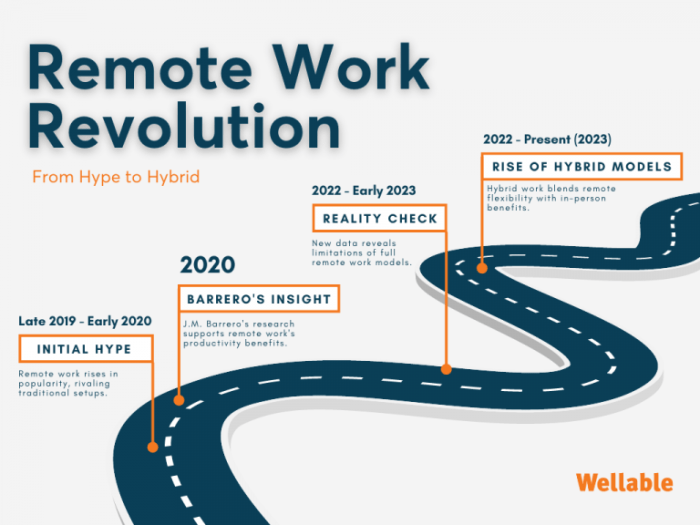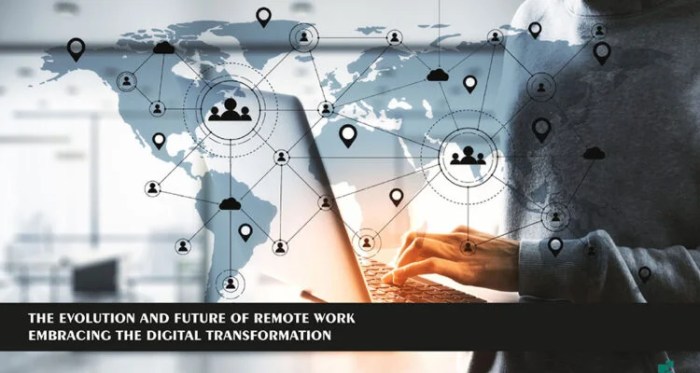In today's rapidly changing work landscape, remote work and the evolution of digital lifestyle have become prominent topics of discussion. This overview delves into the reasons behind the shift to remote work, the role of technology in enabling this change, and the impact on work-life balance and cybersecurity.
The Shift to Remote Work
Remote work has become increasingly popular in recent years, driven by advancements in technology, changing work culture, and the need for flexibility in the modern workplace. This shift has transformed how companies operate and how employees approach their work.
Transformation of Traditional Work Landscape
- Remote work has eliminated the need for a physical office space, reducing overhead costs for businesses.
- Employees are no longer confined to a specific location, allowing companies to tap into a global talent pool.
- Flexibility in work hours and the ability to work from anywhere have increased employee satisfaction and productivity.
Successful Adoption in Various Industries
- Tech Industry: Companies like Google, Facebook, and Microsoft have embraced remote work, offering employees the flexibility to work from home or remote locations.
- Customer Service: Many customer service roles have transitioned to remote work, utilizing virtual call centers and online communication tools.
- Freelancing and Gig Economy: Platforms like Upwork, Fiverr, and Freelancer have enabled individuals to work remotely on a freelance basis across various industries.
Technology and Digital Tools

In today's digital age, technology plays a crucial role in enabling remote work and shaping the evolution of our digital lifestyle. From communication to collaboration, various digital tools have revolutionized the way we work and interact with others.
Role of Technology in Enabling Remote Work
Technology has been instrumental in enabling remote work by providing the necessary infrastructure for employees to stay connected and productive. With the rise of cloud computing, video conferencing tools, project management software, and other digital platforms, remote workers can seamlessly collaborate with team members from anywhere in the world.
- Cloud Computing: Allows for easy access to files and documents from any location, ensuring seamless collaboration among remote teams.
- Video Conferencing Tools: Facilitate face-to-face meetings and discussions, fostering better communication and teamwork.
- Project Management Software: Helps in organizing tasks, tracking progress, and ensuring deadlines are met, enhancing productivity in a remote work setting.
Impact of Technology on Digital Lifestyle
The impact of technology on our digital lifestyle is profound, as it has transformed the way we live, work, and socialize. With the advent of smartphones, social media, and other digital tools, our daily routines have become intertwined with technology, blurring the lines between the physical and virtual worlds.
- Smartphones: Have become an essential tool for communication, entertainment, and productivity, allowing us to stay connected and informed at all times.
- Social Media: Enables us to connect with others, share experiences, and stay updated on current events, shaping how we interact with the world around us.
- Digital Assistants: Such as Siri and Alexa, have become integrated into our daily lives, providing convenience and efficiency in completing tasks and accessing information.
Work-Life Balance
Remote work has significantly impacted the concept of work-life balance for many individuals. With the boundaries between work and personal life becoming blurred, it is crucial to find ways to maintain a healthy balance while working remotely.
Effects of Remote Work on Work-Life Balance
- Increased flexibility in working hours can lead to working longer hours and difficulty in disconnecting from work.
- Reduced commute time allows for more time with family and for personal activities.
- Feeling of always being "on" and difficulty in setting boundaries between work and personal life.
Tips to Maintain Work-Life Balance while Working Remotely
- Establish a designated workspace to create a physical boundary between work and personal life.
- Set specific work hours and stick to them to avoid overworking.
- Take regular breaks throughout the day to recharge and prevent burnout.
- Communicate with your team and manager about your availability and boundaries.
- Engage in activities outside of work to maintain a healthy work-life balance.
Importance of Setting Boundaries in a Digital Work Environment
Setting boundaries in a digital work environment is essential to prevent work from encroaching on personal time and to maintain overall well-being. It helps in reducing stress, improving productivity, and fostering better relationships both at work and home.
Cybersecurity and Data Privacy
In a remote work setup, cybersecurity and data privacy are crucial aspects that need to be carefully managed to protect sensitive information and prevent unauthorized access.
Importance of Cybersecurity in Remote Work
- Use secure and encrypted communication channels for exchanging sensitive data.
- Implement multi-factor authentication to add an extra layer of security.
- Regularly update software and systems to patch security vulnerabilities.
- Educate employees on cybersecurity best practices to prevent phishing attacks and malware.
Best Practices for Ensuring Data Privacy
- Use a virtual private network (VPN) to encrypt internet connections and protect data transmission.
- Avoid using public Wi-Fi networks for work-related tasks to minimize the risk of data breaches.
- Secure devices with strong passwords and enable remote wiping in case of theft or loss.
- Encrypt sensitive files and data stored on local devices or cloud platforms.
Risks Associated with Remote Work in Cybersecurity
- Increased susceptibility to cyber attacks due to decentralized work environments.
- Potential data breaches and leaks if proper security measures are not in place.
- Risks of unauthorized access to company networks and sensitive information.
- Challenges in monitoring and managing cybersecurity risks across a distributed workforce.
Last Point

As we wrap up our discussion on remote work and the evolution of digital lifestyle, it's clear that these trends are reshaping the way we work and live. Embracing technology and setting boundaries are key in navigating this new era of work.
Question Bank
How has remote work transformed the traditional work landscape?
Remote work has shifted the focus from physical office spaces to virtual collaboration, allowing companies to tap into a global talent pool.
What are some best practices for ensuring data privacy while working remotely?
Ensure your devices have the latest security updates, use encrypted communication tools, and avoid public Wi-Fi networks for sensitive work.
Why is setting boundaries important in a digital work environment?
Setting boundaries helps maintain work-life balance, prevents burnout, and establishes clear expectations for both work and personal time.




